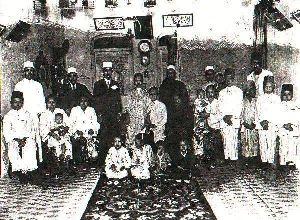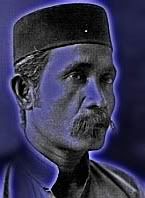My Teacher Mr Nair
There were tall cengal trees in the school ground, and a canopy of green in the far corner of the playground, lush with creepers that hid deep shadows and winding tunnels under the twines and the flowers. Beyond that were the teachers' quarters, wooden houses on short stilts, looking out to Jalan Batas Baru.
It wasn't much of a school, but it did for us things that our fathers never knew. We read books about Old Lob on an English farm, and Percy the bad chick and Dobbins the shire horse and Mr Grunt who was fond of crunchy apples. It was all a million miles away from the padi fields and the swamplands of Paya Bunga, the knitted raft of swampy growth that covered the still water for as far as the eyes could see. There was water hyacinth with flowers of deep blue, and water lilies and broad heart-shaped leaves that spread out for frogs to sit and look out dewy eyed at flying gnats, sometimes dragonflies buzzed above as dragonflies were wont to do.
In the morning, in the trishaw on the way to school, I looked out most days to the soft light that brought out this beautiful magic, of butterfly wings and translucent colours; my classmate Fatimah coming into the light from the shades of kampung trees, as she walked the ridges of the padi fields to the road to school. On rainy days I hid behind the hood listening to the prattle of rainwater, while poor Pak Mat paddled us on to school. For once the distant water buffalo had its hide the same colour as the grey tone of the sky.
Our headmaster was Mr Wee Biau Leng, a bluff man dressed in white shirt and shorts, his trade mark knee-length socks, and a referee's whistle that he blew and blew to keep us from going astray. Tweeeeeet! he'd say, "Saklierd'yu?" It took me a long time to decipher those words, "Is that clear to you?" "Is that clear to you?" And then Tweeeeet, tweeeeet!" he'd go. He was a local man and a good teacher who was as adept in English as he was in Jawi. He once pulled me aside for having abruptly crossed in front of the car of a local Datuk who was speeding out under the cengal trees. "You must say sorry to the Datuk," he said, "Saklierd'yu?" Another time I was called was when I wrote to a national newspaper to ask if what a teacher taught us was true. I can't remember what it was now, but my head still carries the newspaper columnist's answer: "The likelihood of that being true is like snow falling in Kota Baru." I was told that by my doing so I was downgrading the standard of education in Trengganu. So you see, even at that young age I was already a threat to the local order.
I was reminded of these the other day when I received an email from Pok Ku telling me of the sad passing of Mr Ravindran Nair. Mr Nair was a local lad who one day came riding to our primary school on his bicycle. This meant a lot to us, in a school where West-coast born teachers sometimes let slip their view of us as country yokels. Many orang luar children, whose fathers were state surveyors and engineers and panjandrums in the local order were taken under the wings of those out-of-state teachers, who sniffed their air of disdain on all of us down below, and even sometimes criticised the ways of our lingo. Not so Mr Nair who gave us our confidence and taught us that we too could be as clever as they.
Mr Nair taught me the power of the English language, and how to use it in debates and how to use it as a tool. One day, to my great surprise, he went out to the shops and, with his meagre teacher's salary, bought me a Kodak 127 camera and inscribed it in his own handwriting on the box that it was in recognition of my 'contributions' to the school's debating society. I walked tall to the stage to receive that, a big recognition for meagre skills. But Mr Ravindran was like that, he was nothing short of inspirational.
Sadly I never saw him again after I left Kuala Trengganu, which was many years ago. I shall always remember him as a kind man, and a good teacher. And I shall always be grateful to him for that, my proudest day, to be a child in Kuala Trengganu. Thank you Sir, Mr Nair!
See also: Passing of a Friend


